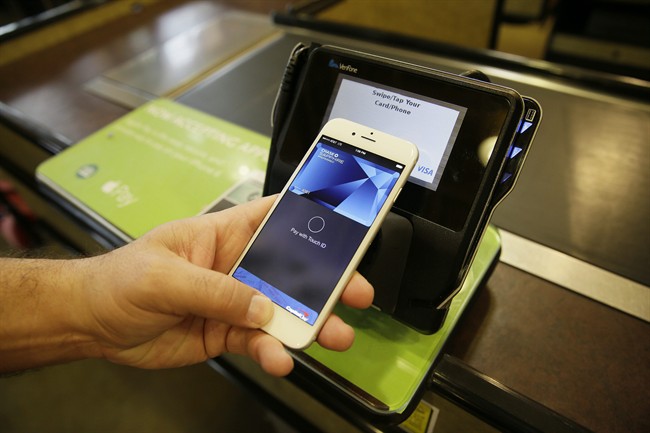Going to the store armed with a wallet full of debit and credit cards may soon be a thing of the past – at least, that’s what the country’s biggest banks are betting on.

This week, the country’s biggest financial institutions announced they had signed on to make Apple Pay – the mobile payment technology that allows iPhone users to pay for things using their smartphone or Apple Watch – available to debit and credit card holders, marking a big step for Canada’s adoption of mobile payment technology.
READ MORE: Big 5 Canadian banks to offer Apple Pay as mobile payments rise in Canada
But while banks are selling mobile payments as a convenient and fast solution for consumers, financial experts warn there could be one big risk associated with digital wallets – overspending.
“The move to digital wallets is another step removed from tangibility,” said Jeff Berry, senior director of research and development at LoyaltyOne.
“As consumers become more and more removed from cash transactions, the amount they spend tends to rise so we can expect to see an increase in spending among those who adopt Apple Pay.”
WATCH: How does Apple Pay work?

It’s the same warning we’ve heard over and over again when it comes to credit cards – the less we use cash, the harder it is to keep track of what we are actually spending.

Get weekly money news
But some experts say we could become even more reckless with overspending once those credit cards are stored on our smartphones.
“It’s been suggested that we reach for our wallets and purses far less often than we reach for our phones, with some data showing smartphone users reach for their devices over 100 times per day,” personal finance expert Preet Banerjee told Global News.
“That means we could see even less impulse control for phone-based payment systems, possibly leading to even higher spending habits versus plastic credit cards.”
This is especially concerning considering Canadians’ personal debt levels have hit new highs in recent times as interest rates remain at historical lows.
Personal finance 101
To prevent this, Banerjee said consumers need to get back to what he calls “personal finance 101” – keeping a monthly budget.
“Gone are the days where you would have to track all your paper receipts and bills to create a good record of your expenses,” he said. “Once you’ve figured out your monthly expenses you can get a better sense of how you are spending your money and where you want to make changes.”
3 key factors in constructing a budget
- Know your net (after tax) income – this is the starting point
- List where your money has to go – food, housing, transportation, medication, etc.
- Understand where the rest of the money goes – and be accurate to the nearest dollar*
*This means you will have to track a few expenses over a period of time, including groceries, coffee and takeout food, cigarettes, alcohol (anything that goes in your mouth), fuel, shopping etc.
The good news is, most mobile wallet apps allow you to see your transaction history quite easily, which means – if you are diligent – you can gain a good sense of how much is being drained from your digital wallet.
READ MORE: Surviving the slump – how to make a budget
Another saving grace: Apple Pay and contactless payments (tap-to-pay debit and credit cards) are limited to transactions under $100. Although this is done for security and fraud prevention reasons, it also prevents you from mindlessly tapping away on big purchases.
You may be more inclined to think twice about your purchase if you have to take the time to punch in your PIN.
Experts also suggest downloading a budgeting app to help keep track of your spending habits. We have a list of some popular choices here.
If you do notice your day-to-day spending is out of control, Banerjee said you might be better off shutting down your digital wallet, leaving your credit cards at home, or using cash to see how much you are actually spending.
Should budgeting be left solely to the consumer?
While setting and sticking to a budget is your responsibility, some experts believe banks and app makers should play a part in preventing the growth of consumer debt.
“I am a firm believer of consumers taking responsibility for their actions; however, having said that, they still need to have mechanisms in place that if they feel they are out of control of their spending that they have help,” said Jeffrey Schwartz, executive director of Consolidated Credit Counseling Services of Canada.
For example, Schwartz suggested Apple could build in a feature to Apple Pay that allows the user to set a monthly budget for the cards they store in their digital wallet.










Comments